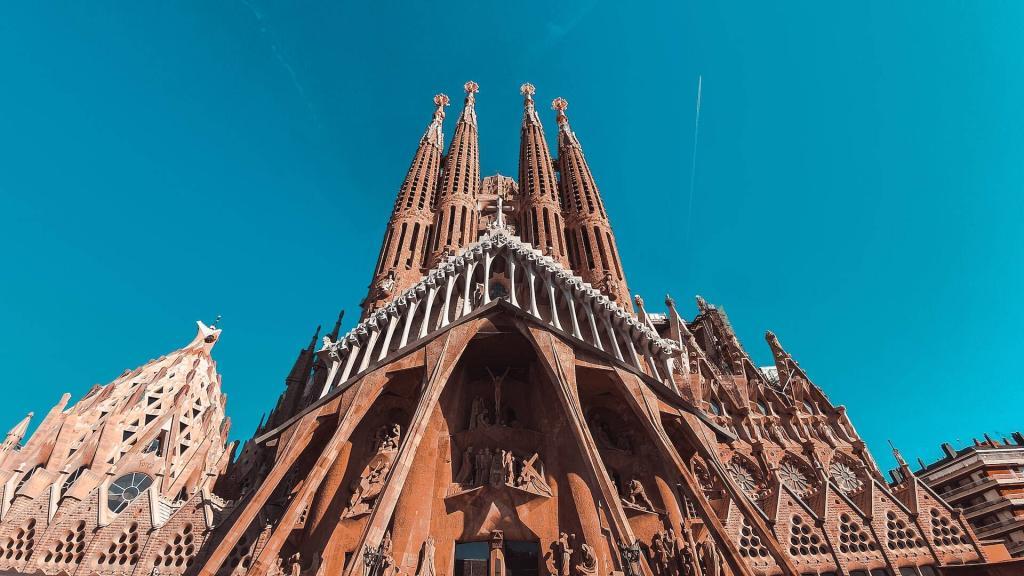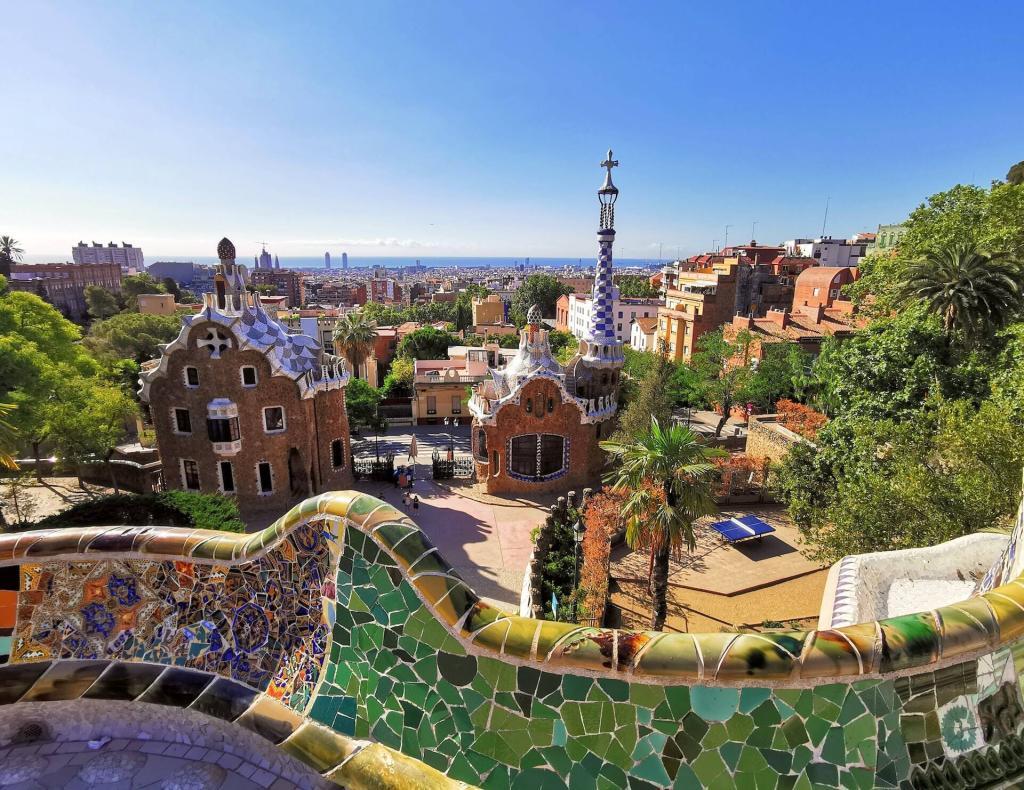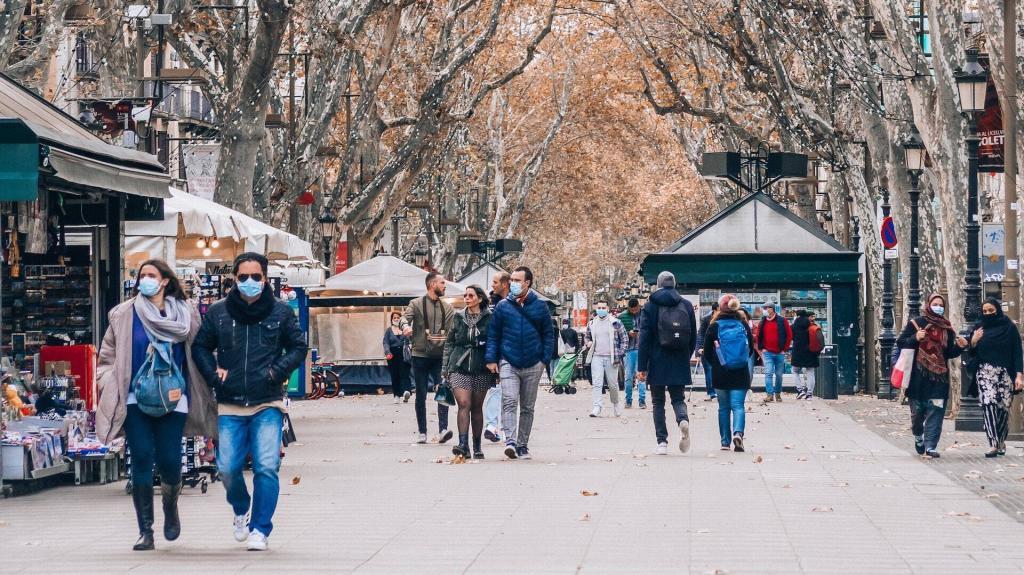Barcelona is our city and we love to share with you everything we discover about it. In this guide you will find everything you need to know to visit Barcelona, such as when it is free to visit museums or exhibitions, the Modernism Route, charming places, when to go, where to stay and what to do. We will also suggest excursions and getaways that can be done from Barcelona.
The capital of the region of Catalonia is a gigantic open-air museum, where the fantastic modernist architectural jewels shine, from Park Güell, designed by the great Antonio Gaudí, to the Sagrada Familia and Casa Batlló.
If you add to that sunny beaches and a gastronomy that is sublimated in the famous tapas, the urban cocktail is really perfect.
Other attractions to see in Barcelona are: the Picasso Museum, the Boqueria Market and the Camp Nou Experience, for fans of the culé, the glorious FC Barcelona.
At a glance:
- You will be fine speaking in English, most people know the basics to indicate you were to go or ordering at restaurants.
- You can’t use Uber in Barcelona right now, download the app Cabify instead. You might need to wait 15 minutes the first time to use the app to ask for ride (it’s part of the deal with the taxi drivers in Barcelona). With Cabify you can also use rent for minutes an electric motorbike.
- Avoid ATM next to Souvenir places, instead go to the main streets and look for a real Bank. You will get less fees and overcharged from evil companies. Most hotels, restaurants, and smaller retailers will accept Mastercard and Visa. There is no need to get cash from an ATM.
- The weather is mild even in winter, just bring a light jacket in Autumn and a bigger coat in the Winter. In Barcelona you will experience more rainy days, usually last a morning or few hours.
Sagrada Familia

The Sagrada Familia is considered the biggest tourist attraction in Spain. It is difficult to remain unmoved by the beauty of this building, which Antonio Gaudí, the maximum reference of modernist architecture, designed starting in 1883 and left unfinished after his death in 1926. After his death, different architects followed Gaudí’s plans to continue with the construction of the building. The expiatory temple of the Sagrada Familia is one of the great attractions to see in Barcelona.
After almost 140 years, the Basilica is still under construction thanks to donations and the contribution of the artistic community. In April 2021 the last milestone was reached: the placement of the pinnacle that crowns the tower of the Virgin Mary, the last detail that was missing to finish that part of the temple.
Both the exterior and the interior are simply fantastic. Three facades, the Nativity, the Passion and the Glory of Jesus (the most monumental) leave tourists speechless. So far 8 towers have been erected, out of the 18 that Gaudí projected in his original sketches.
But it still remains to enter the temple: its characteristic columns, which emulate the trunk of a tree, make the enclosure resemble a large stone forest. The interior of the Sagrada Familia highlights the turn in Gaudí’s work, as from the initial neo-Gothic project he turned to the organic naturalist style, inspired by nature itself.
With an annual budget of almost 80 million euros in construction (and about 4.5 million visitors a year), the Sagrada Familia is expected to be completed in 2026, the year that coincides with the centenary of the death of the brilliant architect.
Park Güell

Another unique place to see in Barcelona is Park Güell, considered one of the most beautiful parks in the world. Strolling through this part of Barcelona is the closest thing to feeling like you are in a Tim Burton movie or a fairy tale. It is named after Eusebi Güell, a businessman who served as patron of Antonio Gaudí, whose works (sculptures, fountains and undulating forms that emulate nature) give the park a life of its own.
We recommend visiting the Plaza de la Naturaleza, with its beautiful mosaics that cover an undulating bench, and the incredible Escalinata del Dragón, with its fountain and the famous dragon sculpture. Also not to be missed are the Casa del Guarda, the Jardines de Austria and the Pórtico de la Lavandera.
The park was inaugurated in 1922 and has an extension of 17 hectares, with sinuous shapes and a thousand colors, representing animals and geometric shapes, with disturbing columns that look like stone trunks. Park Güell is, without a doubt, a fantasy world come true, which only Gaudí could create.
It is worth noting that Park Güell is located in the district of Gracia, a relaxed area with many cafes and restaurants. Highlights include Carrer de Verdi street (which condenses the spirit and mystique of the neighborhood), Plaza del Sol, full of bars, Plaza de la Revolución de Septiembre de 1868 and Plaza de la Vila de Gracia. At night, the streets of Gracia are the perfect place to go out for a drink on warm summer nights.
Rambla and Gothic Quarter

La Rambla is Barcelona’s most famous pedestrian avenue, linking Plaza Cataluña and the Columbus Monument for a kilometer and a half. Tourists, street musicians, artists and vendors parade at all hours along this street, which summarizes the effervescence of Barcelona. La Rambla de Catalunya is an essential place to see in Barcelona.
We recommend stopping at a sunny café (be warned that the prices on the terraces of the Rambla are exorbitant), stroll through the Boqueria Market, enjoy the Mosaic of Miró and stop to drink at the Canaletas fountain; legend has it that whoever does so will return to Barcelona.
The neighboring Gothic Quarter is one of the most beautiful areas of the city, with its labyrinthine medieval cobblestone streets, its Gothic churches, which sit on the remains of Ancient Rome, and its bars and restaurants.
Among the attractions of the Gothic Quarter we recommend visiting the beautiful Cathedral of Santa Eulalia (the cloister is amazing) and then get lost in streets like Carrer del Bisbe, until you reach the Palau del Bisbe, Plaza Sant Felip Neri, the Temple of Augustus, Plaza Sant Jaume and the splendid Plaza Real, located next to the Ramblas.
The Main Synagogue, which testifies that this was an important Jewish quarter, is the oldest in the Iberian Peninsula. To finish the tour, it is well worth having a chocolate with churros in one of the locals in Petritxol street (enclave of chocolate shops in the Ciutat Vella).
Batlló House
Another of the architectural works to see in Barcelona is the famous Casa Batlló. This house is an emblem of Catalan modernism and a world landmark of architecture. It is located at number 43 Paseo de Gracia and its facade, which recreates the undulating forms of nature, is stunning. The building was acquired in 1903 by the businessman Josep Batlló and Antonio Gaudí himself remodeled it between 1904 and 1906. Inside the building, the patio of lights and the unusual chimneys on the roof stand out. It is advisable to hire the audio-guide to understand the conceptual importance of this work of Gaudí. Visiting hours are from 9 am to 9 pm.
Picasso Museum
In the Born neighborhood is located the Picasso Museum, which collects much of the work of the famous painter Pablo Picasso during his youth. In total there are 3,500 works distributed in three Gothic buildings, which make up the largest collection of Picasso that exists in the world. The museum, considered one of the most important in Barcelona, houses famous paintings by the painter, such as Man in a Beret, Science and Charity, Woman with a Coif, The Divan and The Embrace. Admission costs 12 euros but admission is free on the first Sunday of each month and on Thursdays after 6 pm.
National Art Museum of Catalonia
The National Art Museum of Catalonia is one of the museums to see in Barcelona and one of the most important in Spain, famous for housing one of the largest collections of Romanesque art on the planet. It is located on the mountain of Montjüic, in the imposing National Palace of Montjüic, in an area of 32,000 square meters.
Touring this museum takes several hours, as the content is really huge. It is recommended to visit the rooms of Gothic, Romanesque, Baroque, modern art and the incredible collection of 100,000 engravings and drawings. The entrance fee is 12 euros but admission is free on the first Sunday of each month and on Saturdays after 3 pm.
El Born
The neighborhood of El Born is located next to the Gothic Quarter and unfolds between Barceloneta and Via Laietana. It is an area that always manages to be trendy, with its lively tapas bars, cafes and designer boutiques. The epicenter of the neighborhood is the old Born market, around which are the most trendy hotels, restaurants and stores in Barcelona.
The streets of the Born are narrow and cobbled, ideal for strolling for hours, until you reach the beautiful Basilica of Santa Maria del Mar or the Palau de la Música, where the concert calendar is very rich. And then continue walking along the Passeig de Born, Montcada street and be dazzled by the Church of Sant Pere and the Marcus Chapel.
Boqueria Market
Few food markets in the world are as incredible as the Boqueria Market. Located on Las Ramblas, it brings together more than 300 fresh produce stalls in its 2,500 square meters of aisles. Visiting this place is a stimulus for the senses: each stall displays its merchandise in an exuberant way, in an authentic parade of flavors, aromas and colors, from fruits and vegetables to cheeses, meats and all kinds of fish and seafood. The market is open from Monday to Saturday, from 8 a.m. to 8.30 p.m. and is another must-see in Barcelona.
La Pedrera

From the Plaza de Cataluña, up the Paseo de Gracia, you reach one of Gaudí’s masterpieces in Barcelona, the Casa Milá, popularly known as La Pedrera. Its undulating stone façade (Gaudí’s naturalistic architecture stage) is the first thing that catches the eye, while inside it surprises its main floor, which today houses a large exhibition hall. This modernist building has an incredible rooftop space, with quirky chimneys and ventilation towers. La Pedrera is another tourist attraction to see in Barcelona.
Barceloneta
Barceloneta is an old fishermen’s neighborhood that has undergone a spectacular transformation since the late 1990s. It is now an area of beautiful beaches on the Mediterranean, connected by a palm-lined promenade, with open-air gyms and the view of the marinas.
The neighborhood is populated with restaurants and taverns serving the best fresh fish and seafood tapas in Barcelona. After a good lunch, the only thing left to do is to lie on the sand and digest on the beaches that stretch from Barceloneta to Port Olímpic.
Olympic Port
The Olympic Port was built as part of the millionaire infrastructure works required for the 1992 Olympic Games in Barcelona. It stretches between the beaches of Somorrostro and Nova Icària. It is one of the most beautiful marinas on the Mediterranean coast. The area has a large number of terraces, restaurants and pubs, as well as an important shopping center called Marina Village.
Camp Nou Experience
Fans of FC Barcelona, one of the most winning clubs in the history of world soccer, with the genius of Lionel Messi as the maximum reference, have a place where the passion for the culé team is summed up: the mythical Camp Nou stadium and, particularly, the Camp Nou Experience.
This is a guided tour of FC Barcelona’s playing field (passing through the access tunnel and locker rooms), which includes a visit to the interactive museum, where the club’s trophies and top awards shine. It is a great opportunity to meet the great players in the history of the azulgrana team, including Maradona, Ronaldinho, Messi, Iniesta and Xavi. The ticket price is around 30 euros.
How to start planning your trip to Barcelona
Accommodation: In Barcelona there are many areas that we believe are good places to stay. As we live in Barcelona we have not stayed in many accommodations in our city.
We stayed in the W Barcelona hotel during Covid to celebrate Valentine’s Day. This hotel is part of the Marriott brand, a luxury boutique hotel, it’s expensive and we only recommend it if you are planning a romantic getaway.
We know people that also stayed in the BcnStop Parc Güell and has very good communication with the city center.
How to get from the airport to Barcelona
Barcelona can be reached from three airports: Barcelona – El Prat, Girona Costa Brava and Reus.
The closest airport is Barcelona-El Prat airport which is located 15-20km from the city center.
If you want detailed information on how to get there by public transport you can read the following page where we explain how to get from Barcelona to the airports of Reus, Girona Costa Brava and Barcelona-El Prat.
Transportation in Barcelona
Public transport in Barcelona is very good, and one of the best ways to move around the city. We also like to walk around neighborhoods such as the Born, the Gothic or Gracia, as they are neighborhoods with many pedestrian-only streets and you can stroll quietly.
If you decide to take public transport, the transport ticket in Barcelona is integrated. Both metro and train as well as streetcars, buses and trains can be taken with the same transport card (in the case of trains and railroads you will have to look at the zone you want to go and buy one according to the zone number). Except with single tickets you can transfer from one transport to another, as long as it is a different type of transport, during 1h and 15min from the validation.
We recommend you to buy the HolaBCN! or T-10 day cards (10 tickets in one card) depending on the trips you have to make. We do not recommend single tickets because they are more expensive and, as we have already said, you can not transfer.
What to see in Barcelona?
Barcelona is a city that has a lot to see and we love living in this city because we always have new places to discover. In the blog you can read many posts about our beautiful city. If you want to know our 10 must-see places in Barcelona, which by the way we had a hard time choosing, click on the link.
Places to go with children in Barcelona
If what you want to do are visits with your children, here are some of the entries we have on the subject:
Barcelona Modernism Route
Barcelona, Modernism and Gaudi are 3 words that you will not stop reading when you consult a guide of Barcelona. You can’t leave Barcelona without visiting some of these sites of the Modernism Route.
Tips for visiting Barcelona
- Avoid taking single tickets, they do not allow transfers and are very expensive.
- It is not necessary to take an accommodation in the center of Barcelona. There are neighborhoods that are a little further away but in 10 minutes by metro or train you can be in the center and it will be cheaper for sure.
- On weekends and especially at the beginning of the month we find a wide variety of free museums.
- If you travel in summer, the beaches of Barcelona city are usually a bad option. They are very dirty and crowded. For the same price of zone 1 you can take the suburban train and go to Mongat Nord, Sant Pol de Mar, or many other beaches. They are less crowded and much cleaner.
- If you plan to stay many days, we recommend you to do some excursions or travel to other places in within Spain.
